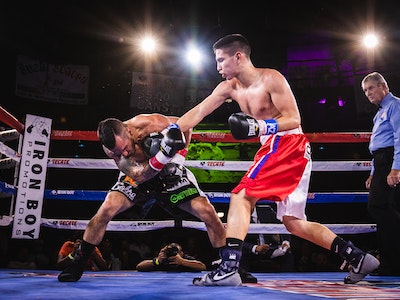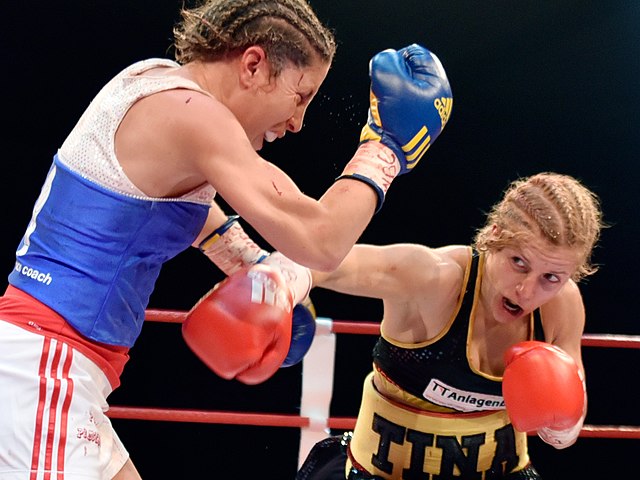Boxing is one of the oldest combat sports in the world. This martial art is known for its effectiveness and efficiency both as a sport and also for its use in self-defense. We’ve compiled the ultimate guide to boxing here at Combat Athlete Gear to help you improve your fight game IQ. In this boxing guide, we cover a range of topics from the history of boxing to boxing terminology and even go over vital boxing equipment. Now that you know the goal of this guide, let’s dive into the history of boxing!
The history of boxing
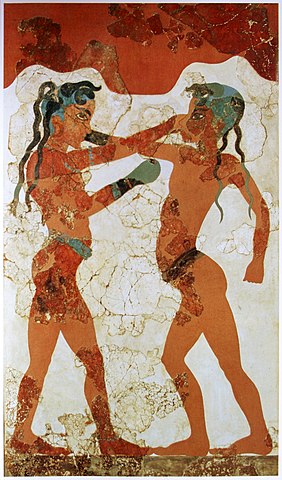
The earliest evidence of boxing goes even farther back in time than the ancient Greeks. Carvings by the Sumerians have been found dating to roughly around the 3rd millennium BCE depicting the art of pugilism. There’s also a relief sculpture from Egypt created around 1350 BCE showing boxers and spectators.
1st century BCE – Development of rules for boxing
As far as we can tell, the beginnings of an official ruleset starts in ancient Greece. Greek boxers didn’t have rounds but the contest could end when one fighter conceded or the other could no longer fight. The Greek boxers during this era fought without hand wraps or gloves. It until 4th century BCE when ox-hide thongs were introduced. These ox-hide thongs were wrapped around the knuckles of boxers and were capable of cutting their opponents.
Romans created their own glove they named the caestus. These gloves had lumps of metal or spikes sewn into the leather which dealt even more damage.
1681- The beginning of the bareknuckle era of boxing
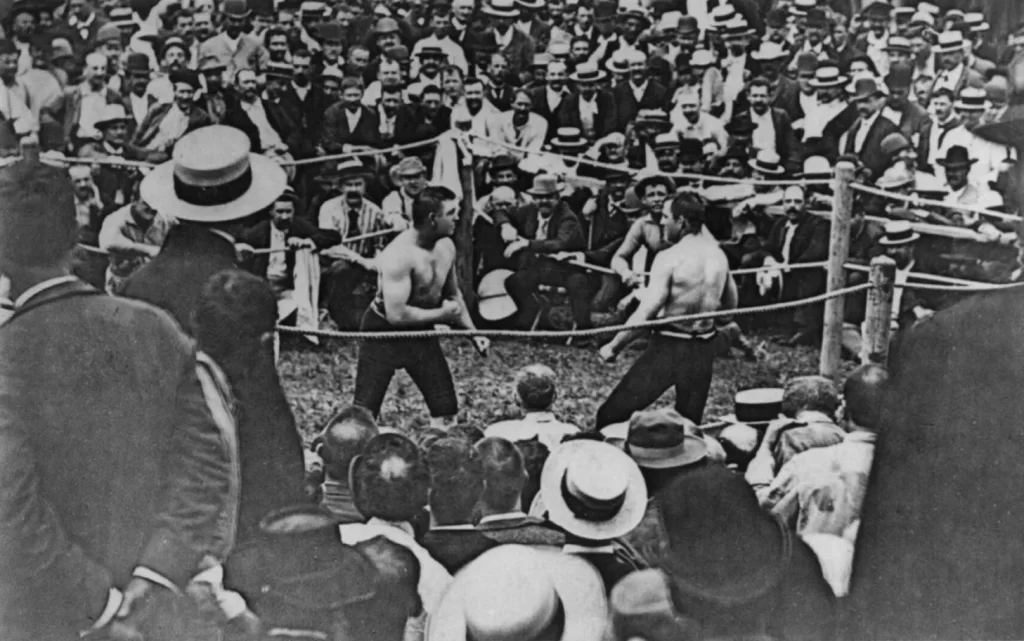
Bareknuckle boxing is exactly what it sounds like. No padding or gloves of any kind were used in these formal bouts. Bareknuckle boxing regularly took place in the Royal Theatre of London. Fighters competed for cash prizes and fans took to placing bets outside of the ring. These fights didn’t have a lot of rules and also lacked weight divisions. There was only one championship that boxers could compete for.
Fights during this time were closer to modern mixed martial arts rulesets than to modern boxing as we’re familiar with today. Boxers were permitted to wrestle their opponent to the ground. Some boxers would even try to land on their opponent during the fall to deliver more damage. There were also strikes thrown to downed opponents.
In 1743, Jack Broughton introduced the first set of rules that led to what we now know as modern boxing. Broughton’s credibility came from being a great prizefighter and also being the student of famed prizefighter James Figg. Rumor has it that Broughton worked on introducing rules and regulations after one of his opponent’s died post-match. Here are some key points of the ruleset introduced by Broughton:
- Wrestling holds were permitted but boxers couldn’t grab an opponent below the waist.
- Rounds continued until a man went down after which the downed opponent had 30 seconds to stand back up. If the downed fighter did not square off/face his opponent, he’d be declared the loser.
- Hitting downed opponents was forbidden.
Along with rules, Broughton also brought something new to the boxing community called mufflers which are the predecessors to the modern boxing glove. One interesting side note is that strikes to the head increased with the use of hand protection resulting in more brain damage. Prior to gloves, boxers went for more body shots to prevent breaking their heads against the skulls of their opponents.
1867 – The Queensberry rules
A new set of rules released in 1867 took boxing to another level in regulating the sport. Through the Queensberry rules which are credited to John Graham Chambers placed a greater emphasis on technique and skill. Here are a few key attributes of the Queensberry rules:
- Fighters wore gloves
- A round was 3 minutes long with a 1 minute of rest in between
- Wrestling was illegal
- A 10-count was implemented
- Weight divisions were introduced
While boxing became more formalized, boxing did deal with some issues in the British culture as some evangelicals were pushing to categorize boxing as a sinful past time.
1897 – Collegiate boxing becomes a reality
Fighters representing Oxford university and Cambridge university occurred in 1897. This was a time period when boxing was considered a required skill for gentlemen and the opportunity to fight was a privilege.
1932 – American intercollegiate boxing is formalized
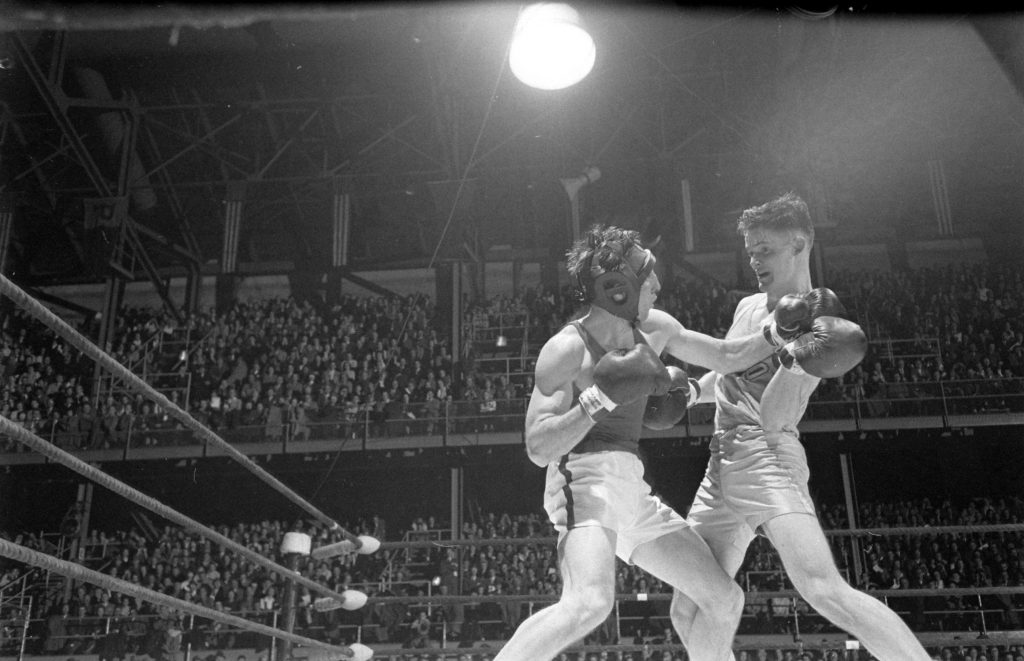
Despite intramural boxing being a reality on many American college campuses, formal competition between schools didn’t occur until 1932. Boxing as a collegiate sport grew in the US during the next couple of decades. The only college sporting events that had greater attendance these boxing tournaments were football games. Some of the best programs during this time were the University of Idaho, University of Virginia, and Washington State.
1950s-1960s – Pro boxing is a part of regular television
As more people tried to find entertainment post-WW2, boxing grew to new heights. Professional boxing matches became a mainstay on television. This development of boxing finding its place in pop culture led to the growth of boxers as personalities as well.
1976 – Boxing proves it’s here to stay in America
5 American boxers won gold medals in the 1976. Making this list included legends like Leon Spinks and Sugar Ray Leonard. The success experienced by these American fighters led to even more popularity in the US for the sweet science. The 1970s also saw greater promotions for boxers as millions of dollars were paid out to the best fighters like heavyweight champ Muhammad Ali.
1993 – Women’s boxing becomes sanctioned by USA Boxing
Although women started to box in organized bouts in the 1700s, the formalization of women’s didn’t really happen until the late 1980s. Different lawsuits helped make boxing more accessible to women. The 1990s saw more women around the world began to take part in boxing in countries such as Russia, Norway, Sweden, and Hungary.
2020s – The rise of the celebrity boxer
The growth of celebrity boxing matches has grown by leaps and bounds in recent years. Past decades saw celebrity boxing matches that were more of a joke than anything else. However, key players such as Jake Paul and Logan Paul has sparked a renewed interest in boxing for online users. The Paul brothers have taken on a range of current pro athletes and retired pro athletes including ex-NBA star Nate Robinson and retired MMA star Anderson Silva.
Why do people choose to box?
While boxing is capable of uniting people as a shared interest, the reasons as to why people start training can vary. Right below are a handful of reasons as to why people start to learn the sweet science:
- Self-defense: This tends to be the top reasons as to why people learn to box. Boxing is an effective skill to have in hand-to-hand altercations. Through boxing workouts and sparring, you can learn different skills such as distance management and defense.
- Fitness: Getting in better shape is a top reason for people to join a boxing gym. Due to the physical nature of boxing, your cardiovascular endurance will naturally improve due to exercises like jumping rope and heavy bag workouts. You’ll also become stronger and more flexibility. People who begin boxing are able to lose weight and improve their self-esteem.
- Fighting: Not everyone in a boxing gym wants to compete but that possibility is always available depending on the gym. Some people who join a boxing gym sign up with the intention to fight as an amateur. There are some who even have the goal of going pro. Either way, the desire for organized competition can be a major motivator for the right person.
Why do you choose to boxing if you’ve already begun training? Let us know in the comments below as to what interests you about the sweet science aka boxing!
Basic boxing terminology
Boxing is a lot more enjoyable when you can speak the language! It’s easy to get lost in the sweet science when you don’t understand terms like pivots, slips, and rolls. Here’s a quick list of terms you should be familiar with:
A basic guide to Boxing gear/equipment
There’s more to boxing gear than just gloves. Here’s a quick guide to the most common/widely used boxing equipment every boxer needs.
- Boxing gloves: Boxing gloves are typically made of leather and are filled with foam or other padding. They are designed to protect the hands and wrists of the boxer.
- Boxing headgear: Boxing headgear is a type of protective gear worn by boxers during training and sparring. It is designed to protect the head and face from injuries such as cuts, bruises, and concussions. Headgear is typically made of padded foam and is adjustable to ensure a snug fit.
- Boxing ring: A boxing ring is a square or rectangular area, enclosed by ropes, in which professional boxers fight. The ring is divided into two equal halves by a vertical rope. The fighters are required to stay within their half of the ring, and the only time they are allowed to leave the ring is when they are given a break by the referee.
- Boxing round: A boxing round is a period of time in which boxers compete against each other. A round can often be 3 minutes or 1 minute long depending on the ruleset and whether or not the fight is a pro or an amateur bout. Boxers typically rest for one minute between rounds.
- Boxing shoes: Boxing shoes are typically made of leather or a synthetic material. They are designed to be lightweight and provide good traction and support.
- Mouthguard: Mouthguards are pieces of plastic or rubber that fit over the teeth and are used to protect them during sports. They can also be used to protect the jaw if it is injured.
- Groin protector: Boxing groin protectors are a type of athletic cup that is worn by men to protect their groin area from injury. They are typically made of a hard plastic or metal and fit inside of the boxer’s underwear. The groin protector helps to absorb the impact of a blow to the groin area and can help to prevent serious injuries, such as a ruptured testicle.
A beginner’s list of punches used in boxing
Here’s a quick list of the most common punches you’ll see in boxing. Let’s begin with the punch that is thrown with the lead hand:
- Jab: A jab is a straight punch thrown with the lead hand. For orthodox fighters, the lead hand is the left hand. For southpaw fighters, the lead hand is the right hand.
- Cross: A cross is a straight punch thrown with the lead hand.
- Lead uppercut: A lead uppercut is thrown with the front hand with an upwards motion.
- Rear uppercut: A rear uppercut is thrown with the back hand in an upwards motion.
- Lead hook: A curved punch with the elbow bent at a 45 degree angle using the lead hand.
- Rear hook: A curved punch with the elbow bent at a 45 degree angle using the rear hand.
- Overhand left: An overhand left punch is typically the most powerful punch for a southpaw fighter.
- Overhand right: An overhand right punch is typically the most powerful punch for an orthodox fighter.
Famous boxers (you may or may not have heard of them)
The list of the famous boxers includes more than just Mike Tyson and Muhammad Ali! Let’s start with the top female boxers of all time:
Greatest female boxers of all time (From Ali to Prazak)
- Laila Ali: Born on December 30, 1977, in Miami, Florida, Laila is the daughter of boxing legend Muhammad Ali and his third wife, Veronica Porsche Ali. Laila Ali followed in her father’s footsteps and became a professional boxer. She made her debut in 1999 and went on to win 24 of her 25 fights, 21 of them by knockout. In 2001, Ali won the Women’s International Boxing Federation (WIBF) super middleweight title, and in 2002 she became the first woman to win the World Boxing Council (WBC) female middleweight title. In 2007, Ali retired from boxing. She now works as a television commentator and is the author of two books: Reach! and I’ll Show You. Ali is also a dedicated advocate for children’s health and wellness. She founded the Laila Ali Lifestyle Brand, which promotes healthy living for kids and families.
- Christy Martin: Christy Martin is a professional boxer who has held world championships in four different weight classes. She is the only woman to have held a world championship in both the lightweight and welterweight divisions. Martin is also the first woman to headline a major boxing card.
- Mia St. John: Mia St. John is a professional boxer who has competed in the super welterweight and welterweight divisions. She is a former WBC and IBA champion. Born in Los Angeles, California, St. John took up boxing at the age of 18, after the death of her father. She won her first amateur bout, and turned professional in 1992. She won her first world title in 1998, when she defeated Juliette Whittaker to win the WBC super welterweight title. She lost the title later that year to Lucia Rijker, but regained it in 1999 with a victory over Hyun-Mi Choi. In 2000, she moved up to the welterweight division and won the IBA title with a victory over Lisa Brown. She lost the title in 2002 to Layla McCarter, but regained it in 2004 with a victory over Miho Kato. In 2006, she lost the title to Zoila Frausto. St. John has also competed in mixed martial arts, and has a record of 2-1. Outside of boxing, St. John is a passionate advocate for animal rights, and has worked with PETA to promote vegetarianism.
- Ann Wolfe: Ann Wolfe is a professional boxer who has held several world championships in her career. She is considered one of the best female boxers of all time. Wolfe is known for her aggressive fighting style and her powerful punches. She has never been knocked out in a professional fight.
- Lucia Rijker: Lucia Rijker is a world champion boxer who has also had a successful career in acting. She was born in the Netherlands in 1967, and began boxing at the age of 14. She turned pro in 1988, and by 1994 had become the world champion in the lightweight division. She defended her title twice before losing it in 1997. In 1998, she moved up to the welterweight division and won the world title, which she held until her retirement in 2004. Rijker has also had a successful career in acting. She made her debut in the 1995 film “Million Dollar Baby”, and has since appeared in a number of films and television shows. She is perhaps best known for her role as Billie in the 2004 film “Kill Bill: Vol. 2”. Rijker is a highly accomplished boxer and actor, and is considered to be one of the best female boxers of all time. She is a three-time world champion, and has won numerous other titles and awards. She is also a successful actress, and has appeared in some of the most popular films and television shows of the last two decades.
- Valerie Letourneau: Valerie Letourneau is a Canadian professional boxer who has competed in the flyweight and strawweight divisions. She is the former WBC and IBF Strawweight Champion.
- Holly Holm: Holly Holm is a professional boxer who has competed in the bantamweight and featherweight divisions. She is the former UFC Women’s Bantamweight Champion and is currently the #2 ranked pound-for-pound female boxer in the world by BoxRec.
- Jackie Fields: Jackie Fields was born in 1908 in Philadelphia, Pennsylvania. She was one of the most successful female boxers of all time, winning the World Featherweight Championship in 1930. She was also the first woman to ever referee a men’s boxing match. Fields died in 1984.
- Jeri Sitzes: Jeri Sitzes is a professional female boxer who has competed in the sport since 2000. She is a two-time world champion, having held the IBF super flyweight title from 2006 to 2007, and the WBC light flyweight title from 2009 to 2010. She has also competed for the WBA flyweight title in 2009.
- Diana Prazak: Diana Prazak is a professional boxer from Australia. She is the current IBF world champion in the lightweight division. Prazak started boxing at the age of 16, and turned professional in 2006. She has since won the IBF world championship, and has also held the WBC Silver lightweight title. Prazak is a highly decorated boxer, with a record of 34 wins and 3 losses. She is known for her fast and powerful punches, and is considered one of the top female fighters in the world.
Greatest male boxers of all time (From ALI to holyfield)
- Muhammad Ali: Muhammad Ali was an American professional boxer and civil rights activist. He was born Cassius Clay on January 17, 1942, in Louisville, Kentucky. Ali began boxing at the age of 12 and won an Olympic gold medal in 1960. He turned professional later that year and quickly became one of the most successful boxers in the world. In 1964, Ali refused to be drafted into the U.S. Army and was banned from boxing for three years. He returned to the ring in 1967 and won the world heavyweight championship by defeating Sonny Liston. Ali defended his title six times before losing to Leon Spinks in 1978. He regained the title in a rematch the following year and retired in 1981. Ali was diagnosed with Parkinson’s disease in 1984. He remained active in the fight against the disease until his death on June 3, 2016. Ali was widely regarded as one of the greatest boxers of all time and was inducted into the International Boxing Hall of Fame in 1990.
- Sugar Ray Robinson: Sugar Ray Robinson was born in 1921 in Ailey, Georgia. He was one of the greatest boxers of all time, and is considered by many to be the best pound-for-pound fighter in history. Robinson won the world welterweight championship five times and the world middleweight championship twice. He was also a six-time world champion in the welterweight, middleweight, and light heavyweight divisions. Robinson was inducted into the International Boxing Hall of Fame in 1990.
- Joe Louis: Joe Louis was born in Alabama in 1914. He was one of the most famous and successful boxers of all time. He was the world heavyweight champion for 12 years, and held the record for the longest unbeaten streak in boxing history. He was an American hero, and a role model for many people. He died in 1981.
- Rocky Marciano: Rocky Marciano was an American professional boxer who competed from 1947 to 1955. He held the world heavyweight championship from 1952 to 1955, and is the only heavyweight champion to have retired undefeated. Born and raised in Brockton, Massachusetts, Marciano was the son of Italian immigrants. He was the only child of Angela and Pasquale Marciano. As a teenager, he worked in a shoe factory and as a driver for a local trucking company. He entered the United States Army in 1943, and was discharged in 1945. After returning to civilian life, Marciano became a professional boxer. He won his first 45 fights, 38 by knockout, and held the world heavyweight championship from 1952 to 1955. In his last fight, he faced Archie Moore, the only boxer to have ever knocked out Marciano. Marciano knocked Moore out in the ninth round to retain the world heavyweight championship. Marciano retired from boxing in 1955 with a record of 49 wins, 0 losses, and 43 knockouts. He was inducted into the International Boxing Hall of Fame in 1990.
- Floyd Patterson: Floyd Patterson was an American boxer who was the first to hold the world heavyweight championship twice. He was born in 1933 in New York City and died in 2006. Patterson was known for his quick and accurate punches, and his defensive style. He was the youngest man to win the world heavyweight championship, at age 21, and the first to regain it, at age 36. Patterson was also the first African American to hold the world heavyweight championship.
- George Foreman: George Foreman was born in Marshall, Texas, in January of 1949. He was one of twelve children, and his father was a preacher. Foreman began boxing at the age of fifteen, and by the time he was eighteen, he had won a gold medal in the 1968 Olympics. Foreman turned professional in 1969, and by 1973 he was the heavyweight champion of the world. He lost the title in 1974, but regained it in 1975. In 1977, Foreman lost the title again, this time to Muhammad Ali. Foreman retired from boxing in 1977, but came out of retirement in 1987. He lost a match to Evander Holyfield in 1991, and retired for good in 1997. Foreman is now a Christian minister, and he has written several books.
- Lennox Lewis: Lennox Lewis was a world heavyweight boxing champion who held the title twice. He was born in London, England in 1965 and began boxing at the age of 12. Lewis had an impressive career, winning 41 of his 44 fights, including 31 by knockout. He was known for his powerful punches and his exceptional defensive skills. In 1993, Lewis became the first British boxer to win a world heavyweight championship. He lost the title in 1994, but regained it in 1999. Lewis retired from boxing in 2004.
- Manny Pacquiao: Manny Pacquiao is a professional boxer from the Philippines. He is the only eight-division world champion in history, and the first boxer to win world titles in eight different weight classes. Pacquiao began his professional boxing career in 1995, and has since won 59 of his 68 fights. In addition to his world titles, he has also won a number of other accolades, including the Fighter of the Year award from Boxing Writers Association of America in 2006 and 2008. He is also a two-time winner of the Ring magazine Fighter of the Year award, and was named the Sports Illustrated Fighter of the Decade for the 2000s. Pacquiao is considered one of the greatest boxers of all time, and is often ranked among the top five pound-for-pound fighters in the world. He is also a popular figure in the Philippines, where he is considered a national hero.
- Mike Tyson: Mike Tyson is a former professional boxer who competed from 1985 to 2005. He held the world heavyweight championship three times, and was the first boxer to hold the WBA, WBC, and IBF heavyweight titles simultaneously. Tyson was the undisputed heavyweight champion and remains the youngest boxer to win the WBC, WBA, and IBF titles at 20 years, 4 months, and 22 days old. Tyson was born and raised in Brooklyn, New York. He was trained by Cus D’Amato, and became one of the most feared boxers in the world. In 1986, he became the youngest heavyweight champion in history, at 20 years, 4 months, and 22 days old. Tyson lost the title in 1990, but regained it in 1996. After being convicted of rape in 1992, Tyson lost his boxing license and spent three years in prison. He retired from boxing in 2005. Since retiring from boxing, Tyson has appeared in a number of films and television shows. He has also been involved in various legal troubles, including a 2006 arrest for cocaine possession and a 2008 conviction for assault. Tyson is currently married to Lakiha Spicer and has four children.
- Evander Holyfield: Evander Holyfield is a retired American boxer who competed in the heavyweight division. He is a four-time world heavyweight champion, and is the only boxer in history to have won the world heavyweight title three times. Holyfield is also the only person to have been champion in both the WBA and IBF. He was inducted into the International Boxing Hall of Fame in 2010.
How to choose the best boxing gym for you

Beginning your boxing journey can feel intimidating but it doesn’t have to be! Here are some helpful tips on finding the best boxing gym for you to train at.
Consider a location less than 30 minutes from your work/home
As you might’ve guessed, reducing travel time for training sessions will make your life a lot easier! The closer you live to your boxing gym, the lower your chances are of missing workouts.
Analyze your budget
Does the pricing for the gym you want to train at work within your budget? If the answer is no then you may want to reconsider a different gym. However, if you really like a gym but the pricing doesn’t quite work, consider restructuring your spending habits. You could also figure out a way to increase your income to cover training costs. You may also want to wait for deals or discounts on membership rates.
Do the trial class
This is a must. If a gym provides a free class or a free week of classes, schedule time to do it! Doing so will help you make a more informed decision.
Pay attention to quality of instruction
The quality of instruction matters. Are the boxing classes being taught by a knowledgable and experienced coach? Is the coach able to explain concepts in a way that you can understand? Does the coach take time to answer your questions?
Talk to gym members to get a feel for the environment
While you attend your trial class(es), take some time to talk to other people around you. Ask them different questions get a feel for the community in the room. You can ask them how long they’ve been training for. You can find out if any them have trained at other gyms and ask why they’re at the gym they currently train at. Take a few moments to also see how friendly everyone is or if they’re too intense for your personality type.
Gym cleanliness and maintenance
One of the last things you want is to get sick when working out! Pay attention to the training environment you’re in during your trial class. Is the gym clean and free of dirt/grime? Is all of the equipment clean and in working condition?
Book your trial class!
Now that you’ve weighed the pros and cons of the boxing gyms in your area, it’s time to take your first class! It might even be time to sign up if you’ve fully committed to a boxing gym that you really like. Once you’ve signed up, commit to training regularly and you’ll see yourself get better at boxing overtime!
